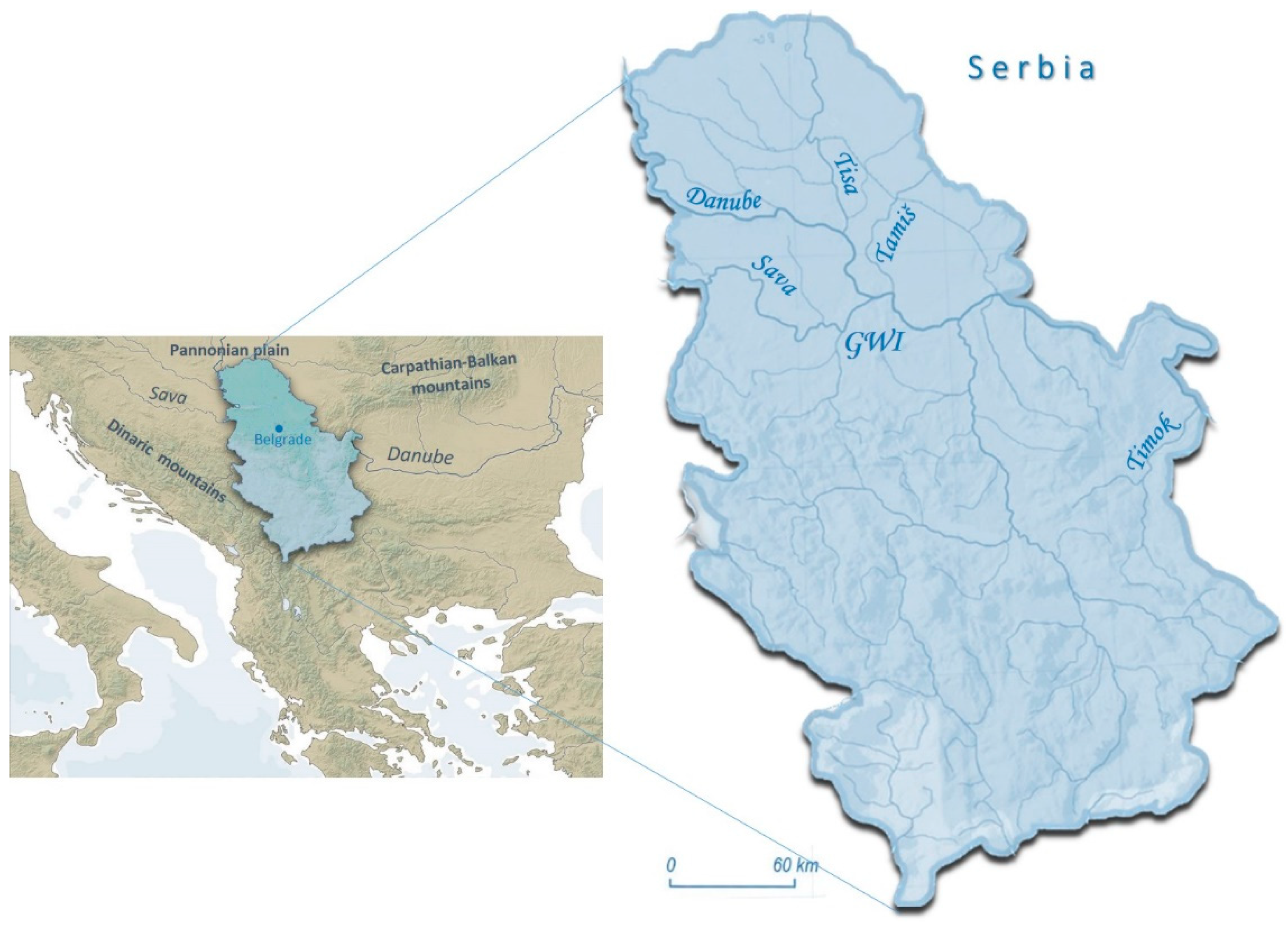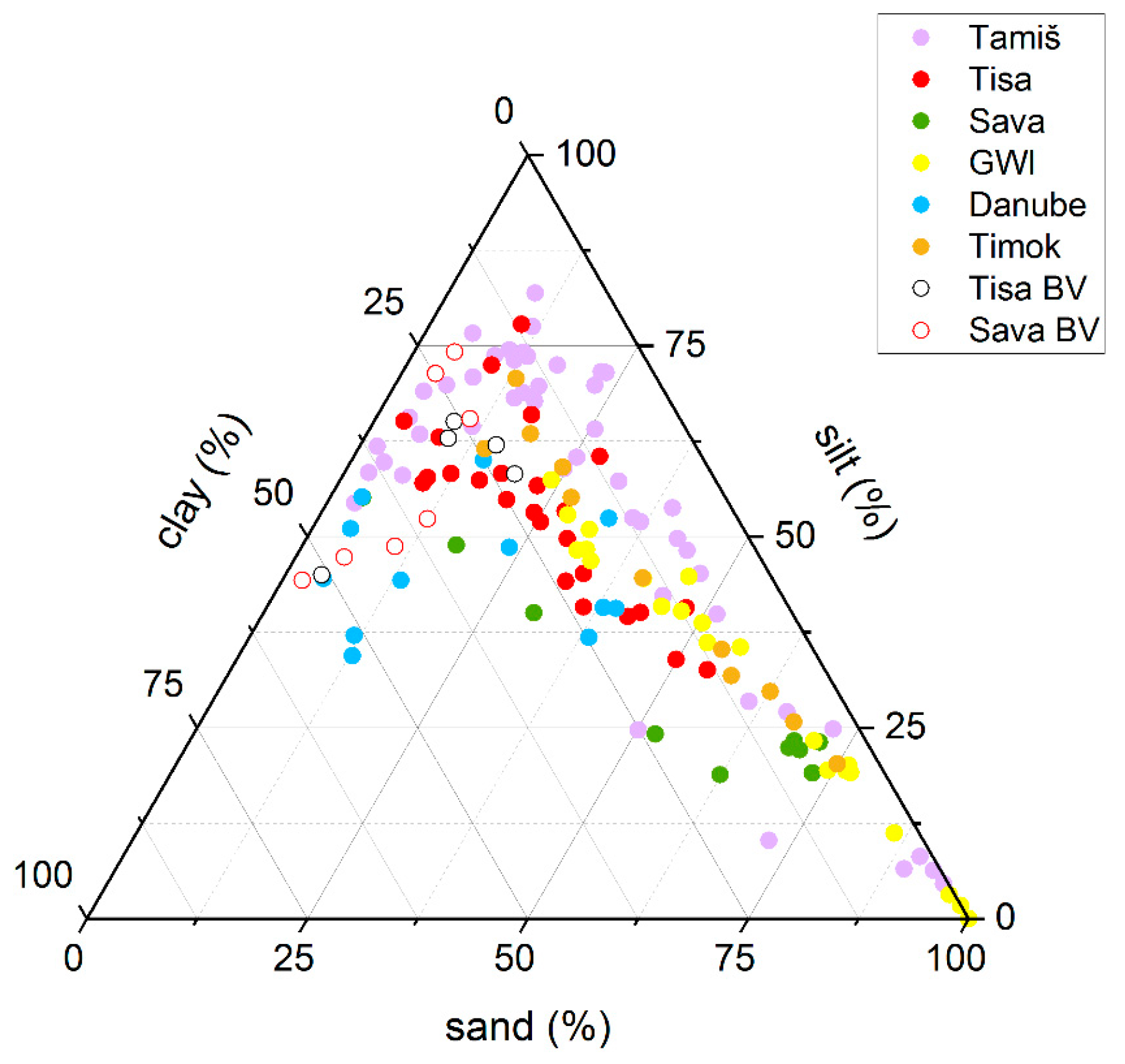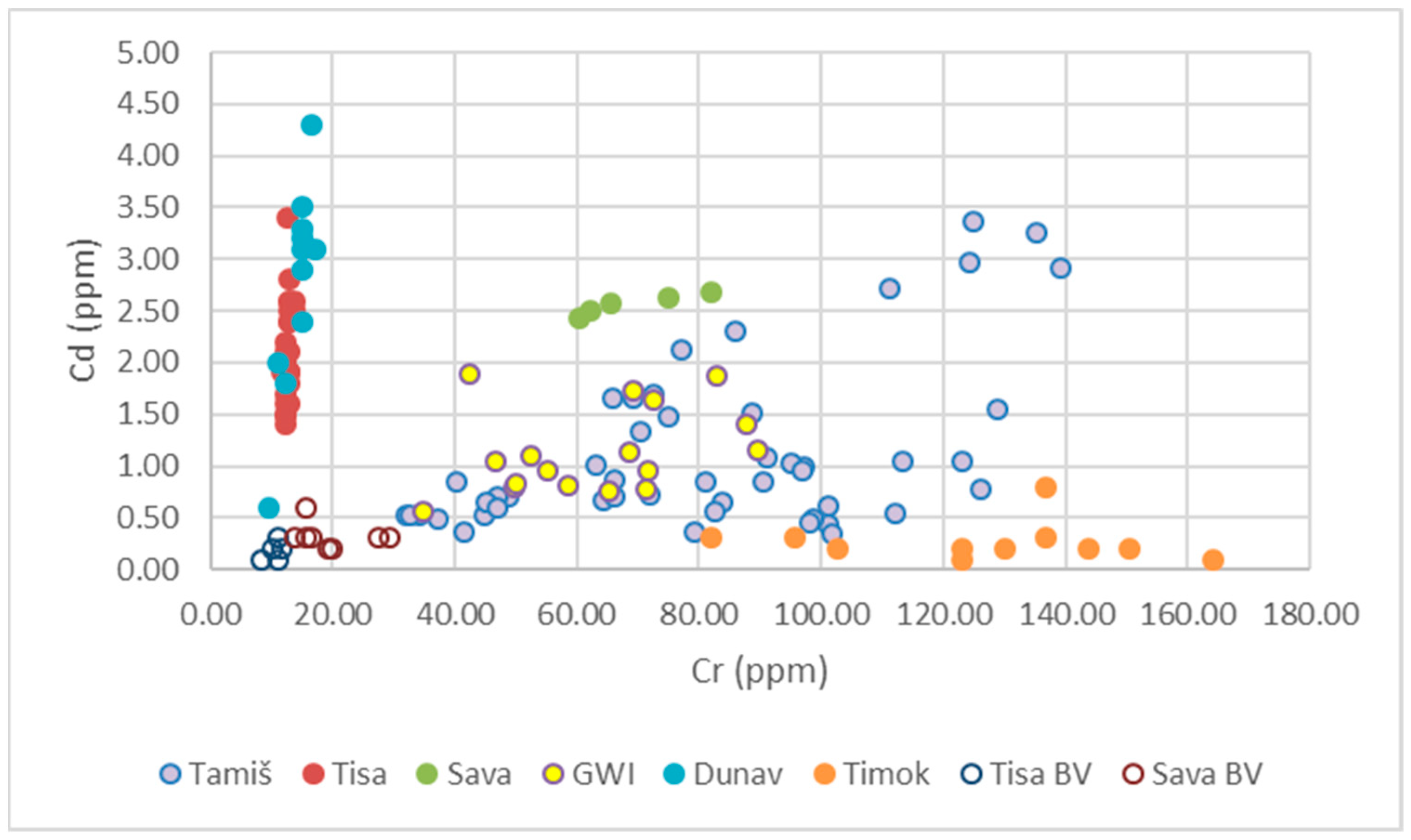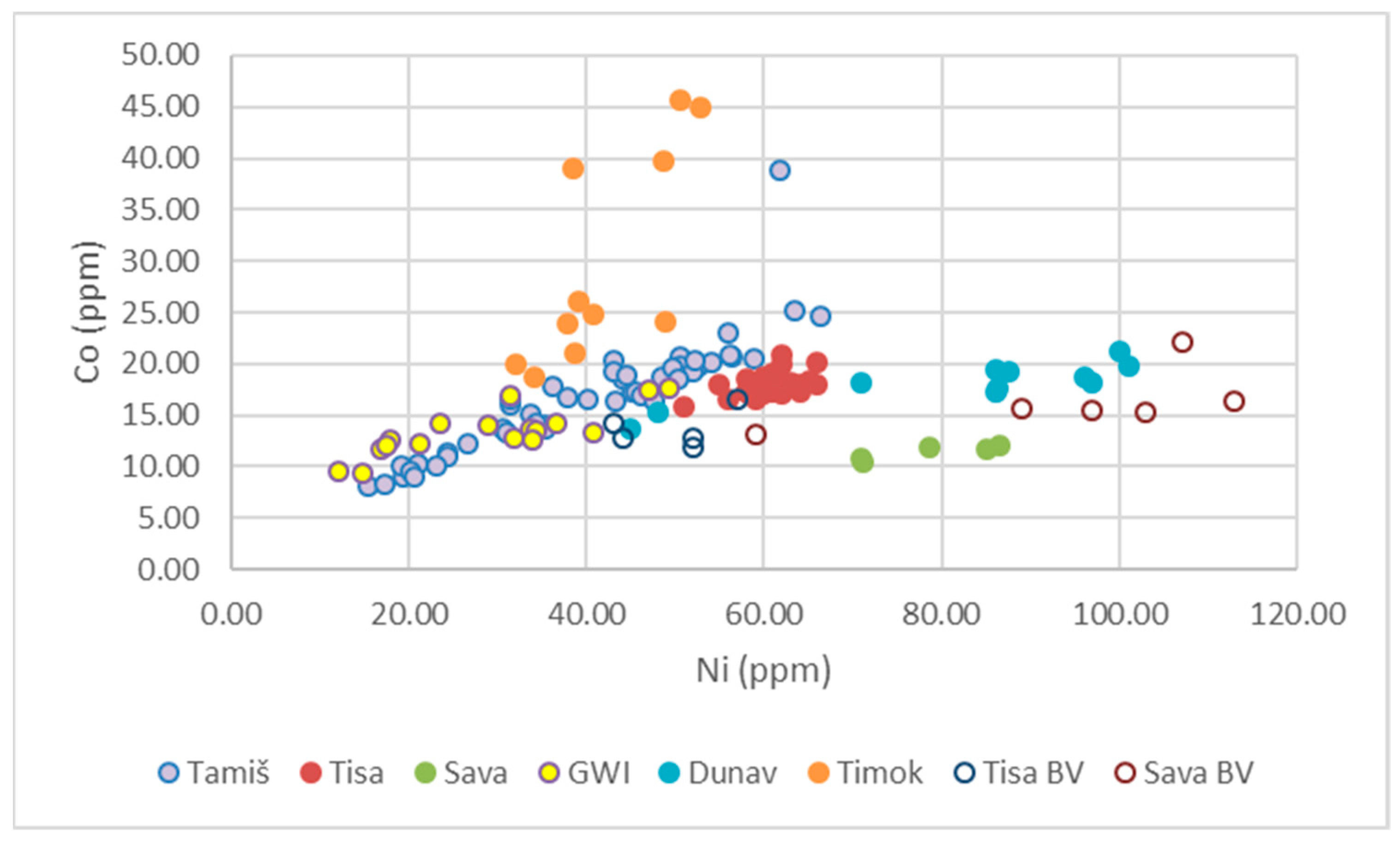Provenance and Pollution Status of River Sediments in the Danube Watershed in Serbia
Abstract
:1. Introduction
2. Study Areas and Methods
3. Results
3.1. Grain Size Composition
3.2. Content of Macroelements
3.3. Content of Heavy Metals
4. Discussion
5. Conclusions
Author Contributions
Funding
Data Availability Statement
Acknowledgments
Conflicts of Interest
References
- Shao, J.; Yang, S.; Li, C. Chemical indices (CIA and WIP) as proxies for integrated chemical weathering in China: Inferences from analyses of fluvial sediments. Sediment. Geol. 2012, 265–266, 110–120. [Google Scholar] [CrossRef]
- Shou, Y.; Zhao, J.; Zhu, Y.; Qiao, J.; Shen, Z.; Zhang, W.; Han, N.; Nunez-Delgado, A. Heavy metals pollution characteristics and risk assessment in sediments and waters: The case of Tianjin, China. Environ. Res. 2020, 212, 113162. [Google Scholar] [CrossRef]
- Kasimov, N.; Shinkareva, G.; Lychagin, M.; Kosheleva, N.; Chalov, S.; Pashkina, M.; Thorslund, J.; Jarsjo, J. River Water Quality of the Selenga-Baikal Basin: Part I—Spatio-Temporal Patterns of Dissolved and Suspended Metals. Water 2020, 12, 2137. [Google Scholar] [CrossRef]
- Filgueiras, A.V.; Lavilla, I.; Bendicho, C. Evaluation of distribution, mobility and binding behavior of heavy metals in surficial sediments of Louro River (Galicia, Spain) using chemometric analysis: A case study. Sci. Total Environ. 2004, 330, 115–129. [Google Scholar] [CrossRef]
- Dendievel, A.; Mourier, B.; Dabrin, A.; Delile, H.; Coynel, A.; Gosset, A.; Liber, Y.; Berger, J.; Bedell, J. Metal pollution trajectories and mixture risk assessed by combining dated cores and subsurface sediments along a major European river (Rhône River, France). Environ. Int. 2020, 144, 106032. [Google Scholar] [CrossRef]
- Varol, M.; Şen, B. Assessment of nutrient and heavy metal contamination in surface water and sediments of the upper Tigris River, Turkey. Catena 2003, 92, 1–10. [Google Scholar] [CrossRef]
- Ntakirutimana, T.; Du, G.; Guo, J.; Huang, L. Pollution and potential ecological risk assessment of heavy metals in a lake. Pol. J. Environ. Stud. 2013, 22, 1129–1134. [Google Scholar]
- Lapwortha, D.J.; Knights, K.V.; Keyc, R.M.; Johnson, C.C.; Emmanuel Ayoade, E.; Adekanmi, M.A.; Arisekola, T.M.; Okunlolae, O.A.; Backmanf, B.; Eklundf, M.; et al. Geochemical mapping using stream sediments in west-central Nigeria: Implications for environmental studies and mineral exploration in West Africa. Appl. Geochem. 2012, 27, 1035–1052. [Google Scholar] [CrossRef]
- Matschullat, J.; Ottenstein, R.; Reimann, C. Geochemical background—Can we calculate it? Environ. Geol. 2000, 39, 990–1000. [Google Scholar] [CrossRef]
- Štrbac, S.; Kašanin-Grubin, M.; Vasić, N. Importance of background values in assessing the impact of heavy metals in river ecosystems: Case study of Tisza River, Serbia. Environ. Geochem. Health 2018, 40, 1247–1263. [Google Scholar] [CrossRef]
- Chelat, B.; Liu, C.; Wang, Q.; Zhang, G. Assessing the influence of lithology on weathering indices of Changjiang river sediments. Chem. Geol. 2013, 359, 108–115. [Google Scholar] [CrossRef]
- Tuzen, M. Determination of trace metals in the River Yesilırmak sediments in Tokat, Turkey using sequential extraction procedure. Microchem. J. 2003, 74, 105–110. [Google Scholar] [CrossRef]
- Gaillardet, J.; Dupre, B.; Allegre, J. Geochemistry of large river suspended sediments: Silicate weathering or recycling tracer? Geochim. Cosmochim. Acta 1999, 63, 4037–4051. [Google Scholar] [CrossRef]
- Turekian, K.K.; Wedepohl, D.H. Distribution of the element in some major units of the earth’s crust. Bull. Geol. Soc. Am. 1961, 72, 175–192. [Google Scholar] [CrossRef]
- Singh, H.; Pandey, R.; Kumar Singh, S.; Shukla, N. Assessment of heavy metal contamination in the sediment of the River Ghaghara, a major tributary of the River Ganga in Northern India. Appl. Water Sci. 2017, 7, 4133–4149. [Google Scholar] [CrossRef]
- Sakan, S.M.; Djordjević, D.S.; Manojlović, D.D.; Polić, P.S. Assessment of heavy metal pollutants accumulation in the Tisza river sediments. J. Environ. Manag. 2009, 90, 3382–3390. [Google Scholar] [CrossRef]
- Sakan, S.M.; Sakan, N.M.; Djordjević, D.S. Trace element study in Tisa River and Danube alluvial sediment in Serbia. Int. J. Sediment Res. 2013, 28, 234–245. [Google Scholar] [CrossRef]
- Foulds, S.A.; Brewer, P.A.; Macklina, M.G.; Haresignb, W.; Betsona, R.E.; Rassner, S.M.E. Flood-related contamination in catchments affected by historical metal mining: An unexpected and emerging hazard of climate change. Sci. Total Environ. 2014, 476–477, 165–180. [Google Scholar] [CrossRef]
- Covelli, S.; Fontolan, G. Application of a normalization procedure in determining regional geochemical baselines. Environ. Geol. 1997, 30, 34–45. [Google Scholar] [CrossRef]
- Rubio, B.; Nombela, M.A.; Vilas, F. Geochemistry of Major and Trace Elements in Sediments of the Ria de Vigo (NW Spain): An Assessment of Metal Pollution. Mar. Pollut. Bull. 2000, 40, 968–980. [Google Scholar] [CrossRef]
- Fok, L.; Peart, M.R.; Chen, J. The influence of geology and land use on the geochemical baselines of the East River basin, China. Catena 2013, 101, 212–225. [Google Scholar] [CrossRef]
- Woitke, P.; Wellmitz, J.; Helm, D.; Kube, P.; Lepom, P.; Litheraty, P. Analysis and assessment of heavy metal pollution in suspended solids and sediments of the river Danube. Chemosphere 2003, 51, 633–642. [Google Scholar] [CrossRef] [PubMed]
- Literathy, P.; Laszlo, F. Harmonisation of micropollutant monitoring in a large international river: Danube. Water Sci. Technol. 1995, 32, 125–137. [Google Scholar] [CrossRef]
- ICPDR. 2023. Available online: https://www.icpdr.org/main/international-commission-protection-danube-river-icpdr-celebrates-world-water-day-2023 (accessed on 28 August 2023).
- Simonović, P. The status of stocks of particular fish species in the River Tisza after the cyanide spill. Acta Biol. Iugosl. Ichthyol. Belgrade 2000, 32, 83–91. [Google Scholar]
- Babović, N.; Marković, D.; Dimitrijević, V.; Marković, D. Some indicators of water quality of the Tamis River. Chem. Ind. Chem. Eng. Q. 2011, 177, 107–115. [Google Scholar]
- Vasić, N. Kompleksna Geoekološka Istraživanja Donjeg Toka Dunava. In Report of Minisrty of Environmental Protection of the Republic of Serbia; Faculty of Mining and Geology, University of Belgrade: Belgreade, Serbia, 2009; Volume 50. (In Serbian) [Google Scholar]
- Kašanin-Grubin, M.; Štrbac, S.; Antonijević, S.; Djogo Mračević, S.; Randjelović, D.; Orlić, J.; Šajnović, A. Future environmental challenges of the urban protected area Great War Island (Belgrade, Serbia) based on valuation of the pollution status and ecosystem services. J. Environ. Manag. 2019, 251, 109574. [Google Scholar] [CrossRef]
- Babic Mladenovic, M.; Kolarov, V.; Damjanovic, V. Sediment regime of the Danube River in Serbia. Int. J. Sediment Res. 2013, 28, 470–485. [Google Scholar] [CrossRef]
- Kašanin-Grubin, M.; Hagemann, L.; Gajica, G.; Štrbac, S.; Jovančićević, B.; Vasić, N.; Šajnović, A.; Djogo Mračević, S.; Schwarzbauer, J. Geochronological investigation of the Danube Djerdap Lake sediments (Serbia): Sedimentology and inorganic composition. Environ. Geochem. Health 2020, 42, 693–707. [Google Scholar] [CrossRef]
- Hakanson, L. An ecological risk index for aquatic pollution control: A sedimentological approach. Water Resour. 1980, 14, 975–1001. [Google Scholar]
- Shepard, F.P. Nomenclature based on sand-silt-clay ratios. J. Sediment Petrol. 1954, 24, 151–158. [Google Scholar]






| Sample | SiO2 | Al2O3 | Fe2O3 | MgO | CaO | Na2O | K2O | TiO2 | P2O5 | MnO | |
|---|---|---|---|---|---|---|---|---|---|---|---|
| Tamiš | A | 48.98 | 15.19 | 5.97 | 2.51 | 2.46 | 0.97 | 2.41 | 0.91 | 0.30 | 0.16 |
| SD | 6.34 | 1.47 | 1.30 | 0.54 | 2.35 | 0.26 | 0.26 | 0.08 | 0.13 | 0.07 | |
| Tisa | A | 56.37 | 15.16 | 6.32 | 2.22 | 3.36 | 1.12 | 2.57 | 0.85 | 0.23 | 0.18 |
| SD | 1.66 | 0.93 | 0.56 | 0.25 | 0.89 | 0.08 | 0.16 | 0.04 | 0.01 | 0.03 | |
| Sava | A | 48.34 | 13.87 | 6.35 | 3.05 | 8.34 | 0.67 | 2.10 | 0.74 | 0.21 | 0.23 |
| SD | 2.07 | 0.47 | 0.27 | 0.33 | 1.10 | 0.13 | 0.14 | 0.04 | 0.03 | 0.08 | |
| GWI | A | 46.51 | 16.45 | 7.13 | 3.80 | 9.33 | 0.70 | 2.71 | 0.92 | 0.34 | 0.18 |
| SD | 2.08 | 1.21 | 1.07 | 0.32 | 1.67 | 0.13 | 0.32 | 0.11 | 0.08 | 0.05 | |
| Danube | A | 47.91 | 13.99 | 5.93 | 3.11 | 8.00 | 0.84 | 2.34 | 0.69 | 0.26 | 0.14 |
| SD | 0.96 | 1.35 | 0.58 | 0.29 | 1.55 | 0.11 | 0.22 | 0.02 | 0.04 | 0.03 | |
| Timok | A | 53.17 | 15.06 | 7.40 | 3.16 | 4.17 | 1.94 | 1.52 | 0.94 | 0.18 | 0.14 |
| SD | 3.65 | 1.31 | 1.34 | 0.96 | 1.98 | 0.36 | 0.61 | 0.12 | 0.07 | 0.03 | |
| Tisa BV | A | 58.07 | 14.20 | 5.73 | 2.84 | 4.76 | 1.29 | 2.36 | 0.84 | 0.16 | 0.11 |
| SD | 6.02 | 1.40 | 0.57 | 0.86 | 3.72 | 0.09 | 0.24 | 0.07 | 0.01 | 0.04 | |
| Sava BV | A | 48.46 | 13.32 | 5.56 | 2.99 | 8.27 | 0.67 | 2.28 | 0.65 | 0.10 | 0.15 |
| SD | 5.03 | 3.61 | 1.27 | 0.70 | 1.98 | 0.19 | 0.74 | 0.12 | 0.03 | 0.08 | |
| Sample | As | Cd | Co | Cr | Cu | Ni | Pb | Zn | Order of Element Content | |
|---|---|---|---|---|---|---|---|---|---|---|
| Tamiš | A | 28.10 | 1.13 | 16.83 | 81.76 | 90.50 | 40.46 | 35.22 | 164.92 | Zn > Cu > Cr > As > Ni > Pb > Co > Cd |
| SD | 8.68 | 0.81 | 5.47 | 29.80 | 59.39 | 13.72 | 28.77 | 83.54 | ||
| Tisa | A | 16.54 | 2.12 | 18.02 | 12.69 | 77.58 | 60.56 | 49.22 | 312.12 | Zn > Cu > Ni > Pb > As > Co > Cr > Cd |
| SD | 1.42 | 0.48 | 1.17 | 0.52 | 10.41 | 3.45 | 9.28 | 35.14 | ||
| Sava | A | 9.84 | 2.57 | 11.39 | 69.08 | 28.71 | 78.49 | 27.29 | 149.84 | Zn > Ni > Cr > Pb > Cu > Co > As > Cd |
| SD | 0.68 | 0.10 | 0.69 | 9.22 | 1.30 | 7.37 | 0.66 | 10.76 | ||
| GWI | A | 12.97 | 1.14 | 13.40 | 62.87 | 146.02 | 28.96 | 62.37 | 177.13 | Zn > Cu > Cr > Pb > Ni > Co > As > Cd |
| SD | 7.78 | 0.42 | 2.34 | 15.92 | 95.85 | 11.20 | 28.96 | 57.07 | ||
| Danube | A | 15.05 | 2.75 | 18.05 | 14.24 | 98.79 | 82.17 | 91.45 | 353.91 | Zn > Cu > Pb > Ni > Co > Cr > As > Cd |
| SD | 5.55 | 1.00 | 2.13 | 2.31 | 39.20 | 19.58 | 27.58 | 93.97 | ||
| Timok | A | 18.25 | 0.26 | 29.82 | 126.27 | 50.87 | 42.03 | 24.27 | 73.09 | Cr > Zn > Cu > Ni > Co > Pb > As > Cd |
| SD | 7.32 | 0.19 | 10.31 | 24.55 | 17.50 | 7.01 | 5.47 | 14.57 | ||
| Tisa BV | A | 6.70 | 0.18 | 13.64 | 10.40 | 23.88 | 49.60 | 14.14 | 71.00 | Zn > Ni > Cu > Pb > Co > Cr > As > Cd |
| SD | 2.93 | 0.08 | 1.85 | 1.32 | 4.10 | 5.94 | 3.34 | 12.92 | ||
| Sava BV | A | 12.58 | 0.31 | 18.29 | 19.67 | 31.16 | 126.25 | 28.68 | 72.50 | Ni > Zn > Cu > Pb > Cr > Co > As > Cd |
| SD | 9.98 | 0.12 | 4.51 | 5.76 | 10.96 | 63.23 | 19.65 | 24.81 | ||
| Sample | As | Cd | Co | Cr | Cu | Ni | Pb | Zn |
|---|---|---|---|---|---|---|---|---|
| Sava/Sava BV | 0.78 | 8.20 | 0.62 | 3.51 | 0.92 | 0.62 | 0.95 | 2.07 |
| GWI/Sava BV | 1.03 | 3.65 | 0.73 | 3.20 | 4.69 | 0.23 | 2.18 | 2.44 |
| Danube/Sava BV | 1.20 | 8.77 | 0.99 | 0.72 | 3.17 | 0.65 | 3.19 | 4.88 |
| Tisa/Tisa BV | 2.47 | 11.78 | 1.32 | 1.22 | 3.25 | 1.22 | 3.48 | 4.40 |
| Tamiš/Sava BV | 2.23 | 3.59 | 0.92 | 4.16 | 2.90 | 0.32 | 1.23 | 2.27 |
| Tamiš/Tisa BV | 4.19 | 6.25 | 1.23 | 7.86 | 3.79 | 0.82 | 2.49 | 2.32 |
| Heavy Elements | First Factor | Second Factor | Third Factor |
|---|---|---|---|
| As | 0.70 | ||
| Cd | 0.886 | ||
| Co | 0.70 | ||
| Cr | 0.85 | ||
| Cu | 0.58 | 0.48 | |
| Ni | 0.86 | ||
| Pb | 0.853 | ||
| Zn | 0.897 |
Disclaimer/Publisher’s Note: The statements, opinions and data contained in all publications are solely those of the individual author(s) and contributor(s) and not of MDPI and/or the editor(s). MDPI and/or the editor(s) disclaim responsibility for any injury to people or property resulting from any ideas, methods, instructions or products referred to in the content. |
© 2023 by the authors. Licensee MDPI, Basel, Switzerland. This article is an open access article distributed under the terms and conditions of the Creative Commons Attribution (CC BY) license (https://creativecommons.org/licenses/by/4.0/).
Share and Cite
Kašanin-Grubin, M.; Gajić, V.; Veselinović, G.; Stojadinović, S.; Antić, N.; Štrbac, S. Provenance and Pollution Status of River Sediments in the Danube Watershed in Serbia. Water 2023, 15, 3406. https://doi.org/10.3390/w15193406
Kašanin-Grubin M, Gajić V, Veselinović G, Stojadinović S, Antić N, Štrbac S. Provenance and Pollution Status of River Sediments in the Danube Watershed in Serbia. Water. 2023; 15(19):3406. https://doi.org/10.3390/w15193406
Chicago/Turabian StyleKašanin-Grubin, Milica, Violeta Gajić, Gorica Veselinović, Sanja Stojadinović, Nevena Antić, and Snežana Štrbac. 2023. "Provenance and Pollution Status of River Sediments in the Danube Watershed in Serbia" Water 15, no. 19: 3406. https://doi.org/10.3390/w15193406
APA StyleKašanin-Grubin, M., Gajić, V., Veselinović, G., Stojadinović, S., Antić, N., & Štrbac, S. (2023). Provenance and Pollution Status of River Sediments in the Danube Watershed in Serbia. Water, 15(19), 3406. https://doi.org/10.3390/w15193406






